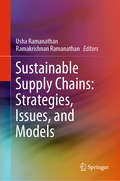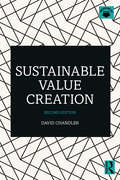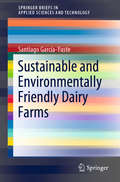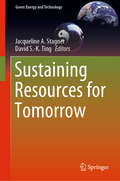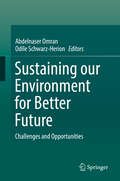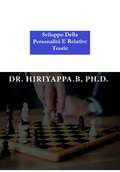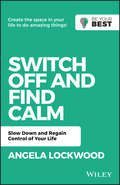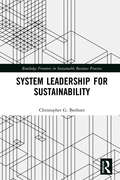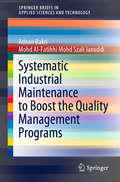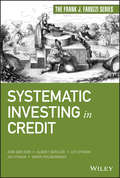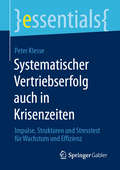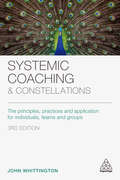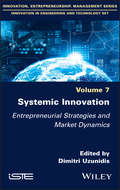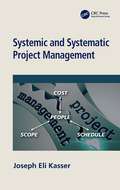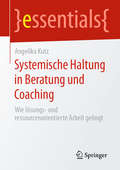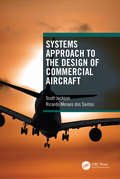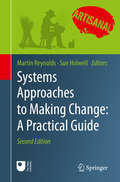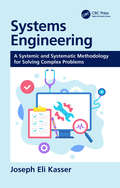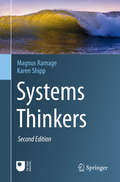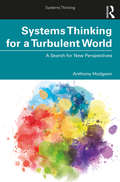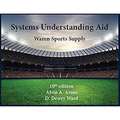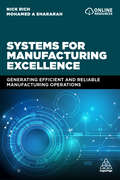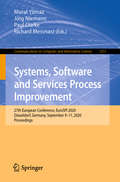- Table View
- List View
Sustainable Supply Chains: Strategies, Issues, and Models
by Usha Ramanathan Ramakrishnan RamanathanThis book discusses supply chain issues and models with examples from actual case studies. Recent advances in sustainability, supply chains and technologies have brought promising potential for the management of sustainable global and local supply chains. While most of the current literature seem to consider developments in the field of sustainable supply chains and in the field of Industry 4.0 as two distinct entities, this book attempts to explore the synergy in bringing these two distinct fields together. The book features chapters on management of sustainability and industry 4.0 on supply chains as a whole, with several case studies on issues related to the application of sustainable supply chains in specific application sectors. They employ mathematical modeling and statistical analyses, as well as descriptive qualitative studies. They cover a range of application areas including multiple sectors (restaurant, manufacturing, logistics, furniture, food and insurance), domains (supply chains, logistics, marketing, and reverse logistics) and multiple country contexts (UK and India). The potential links between sustainability and the recent technological innovations from Industry 4.0 have been explored in detail. The book offers a valuable tool for managerial decision-making on the current practice and future potential on the use of Industry 4.0 tools for sustainable supply chains to facilitate competitive advantage with case studies in various industry sectors. In addition, some intriguing mathematical models will appeal to students and researchers interested in modeling the logistics process and the application of evolutionary game theory for integrating the social and economic aspects of sustainable supply chains. Some of these supply chain issues have been addressed in a previous book by the Editors.
Sustainable Tourism Practices in the Mediterranean (Contemporary Geographies of Leisure, Tourism and Mobility)
by Colin Johnson Ipek Kalemci Tüzün Mehmet ErgülSustainable Tourism Practices in the Mediterranean showcases and examines the current and future trends in sustainable tourism in this popular region where tourism is one of the leading determinants of economic development. This volume examines the effects of specific recent events including terrorism, financial crises and various political changes in the Mediterranean region. Looking at a range of destinations, island and mainland, urban and rural, summer and winter and emergent and declining zones, it provides a comprehensive overview of this area. It also draws on a number of wide-ranging themes such as gastronomy, (corporate) social responsibility, entrepreneurship, ethical issues, service quality, health and the slow city, offering an insightful study of the challenges the Mediterranean region faces and the sustainable practices that can be implemented in order to overcome them. Written by leading academics in the field, this book will be of great interest to upper-level students, researchers and academics in Tourism, Development Studies and Geography.
Sustainable Value Creation: Stakeholders, Globalization, And Sustainable Value Creation
by David ChandlerThe framework presented in this book, Sustainable Value Creation, is the result of more than twenty years thinking and writing at the intersection of two subjects, strategy and CSR. I teach strategy and I think about CSR, almost constantly. Given my academic home in the business school, I appreciate the importance of markets and the ability of their essential actors (for-profit firms) to create value. Equally, of course, I see the ability of firms to destroy value, on an all-too-frequent basis. As such, I have spent a lot of time thinking about how to promote the beneficial work firms do and eradicate the harm. The result is this book: a framework through which managers can understand the essential purpose of the for-profit firm, the most powerful entity we have devised to drive societal progress. At its core, this book is structured around the ten principles that define Sustainable Value Creation. The foundation for these principles is a pragmatic philosophy, oriented around stakeholder theory and designed to appeal to managers skeptical of existing definitions of CSR, sustainability, or business ethics. It is also designed to stimulate thought within the community of academics committed to these ideas, but who approach them from more traditional perspectives. Ultimately, therefore, this book aims to reform both business practice and business education. By building a theory that redefines CSR as central to everything the firm does (as opposed to peripheral practices that can be marginalized), these ten principles redefine how firms approach each of their operational functions, but also how these subjects should be taught in universities worldwide. As such, this book will hopefully be of value to instructors as a complement to their teaching, students as a guide in their education, and managers as a framework to help them respond to the complex, dynamic context that they are expected to navigate every day.
Sustainable and Environmentally Friendly Dairy Farms (SpringerBriefs in Applied Sciences and Technology)
by Santiago García-YusteSustainable and Environmentally Friendly Dairy Farms presents an innovative environmental proposal. While chiefly focusing on dairy farms, the environmental solution it describes is applicable to the entire livestock sector. The book is divided into five chapters, the first of which addresses the carbon footprint of dairy farms. Chapter two provides an overview of the animal production system, focusing on the physiology of the ruminant stomach and the greenhouse gases emitted by dairy cows. In turn, the third chapter covers dairy farm systems, explaining both intensive and extensive husbandry systems. The book’s final two chapters present the-state-of-art in CO2 capture, and describe a new and innovative CO2-RFP strategy. Given its scope, the book will be of interest to chemists, biologists, biotechnologists, and researchers active in agriculture and food-related areas, as well as those working in the food and dairy industry.
Sustaining Resources for Tomorrow (Green Energy and Technology)
by David S.-K. Ting Jacqueline A. StagnerThis book reflects the current state of knowledge on sustainability in a wide range of fields, from engineering to agriculture, to education. Though primarily intended to offer an update for experts and researchers in the field, it can also be used as a valuable educational tool for relevant undergraduate and graduate courses. Key aspects covered include the better and more responsible engineering and management of energy conversion processes, the development of renewable energy technologies, and improvements in conventional energy utilization and food production. In addition, the book addresses green buildings, the green economy, waste and recycling, water, ecopolitics and social sustainability.
Sustaining our Environment for Better Future: Challenges and Opportunities
by Odile Schwarz-Herion Abdelnaser OmranThis book covers a variety of topics regarding environmental practices in our day-to-day lives, as well as topics concerning sustainable development as a broader concept embracing ecological, social, and economic aspects to improve the quality of life for people around the world. Starting with the traditional controversy between the neoclassical economy and sustainable economy, which may be overcome by scientific progress due to more intensive scientific studies of the sustainability paradigm, the book proceeds to discuss various problems and challenges regarding environmental protection and sustainable development in different countries and on different continents. This includes analyses of recent, sometimes fatal mining disasters in South and North America, challenges and opportunities for rural development in Africa and Australia, an exploration of the role of women for sustainable development in Palestine, water safety and water security issues in Asia and Australia, the environmental exploitation of popular tourism destinations like Acapulco, and deforestation in Malaysia, suggesting innovative approaches to turn challenges into opportunities to effectively tackle these problems. Other topics addressed involve sustainable energy creation for future generations, a research survey among Romanian students on sustainable consumption behavior, validity testing for a heat transfer model in a greenhouse, and a case study on sustainability risk management practices at Malaysia’s environmentally sensitive companies. The book closes with an examination of highly digitalized Smart Cities as a potentially valuable complement to conventional urban and rural lifestyles in connection with achieving the UN Sustainable Development Goals (SDGs).
Sviluppo della personalità e relative teorie
by Dott. B. HiriyappaQuesto libro aiuta ad acquisire una maggiore fiducia in se stessi. Inoltre, aiuta a migliorare la propria autostima, l’autocontrollo e l’autovalutazione lungo tutte le fasi della vita. Crea un impatto positivo sulla propria vita personale. Aiuta l'individuo a focalizzare la propria attenzione su tratti personali come l’aspetto, il carattere, l'intelligenza, l'attrattività, l'efficacia, lo stile, l'atteggiamento, la mentalità, la fiducia, l'onestà, la leadership, il coraggio, la pazienza e il comportamento. Aiuta a determinare le responsabilità, i ruoli interattivi sul posto di lavoro, la presa di giuste decisioni, il modo di vestirsi per impressionare e migliorare la propria personalità dando il meglio sul posto di lavoro. Dai meccanismi di difesa di Sigmund Freud alla teoria dei tratti di Gordon Allport, l'autore descrive l'importanza di una personalità di successo in varie circostanze lavorative. L'equilibrio tra i tratti ereditati e le competenze acquisite fa parte sia dello sviluppo della società che dell’ambito lavorativo. Ci influenza tutto ciò che ci circonda! Che si tratti di individui estroversi o introversi, il dottor Hiriyappa delinea le esigenze di un posto di lavoro e la scelta che un potenziale datore di lavoro farebbe tra i due durante un colloquio di lavoro. Ciò che rende interessante questa lettura è la sua connessione contestuale con i millenni contemporanei e i dipendenti esperti che concordano sul fatto che la personalità di un individuo può essere ripugnante o attraente ed è proprio la personalità di una persona, se utilizzata in un certo modo, può portare a ottimi risultati in ambito lavorativo.
Switch Off and Find Calm: Slow Down and Regain Control of Your Life (Be Your Best)
by A. LockwoodSlowing down is not a luxury, it is a necessity Have you ever felt as though everyone wants too much from you? Does your life feel so full there is no room to do the things you enjoy? Do you feel as though life at full throttle is consuming you? Occupational therapist Angela Lockwood shows you how to recognise overwhelm and overstimulation, build habits that help you flick the switch, and re-energise both your mind and body. With Switch Off and Find Calm, you will learn to recognise when it's time to switch off and discover practical ways to make that happen.
System Leadership for Sustainability (Routledge Frontiers in Sustainable Business Practice)
by Christopher G. BeehnerThis book is the first to explore the application of system leadership to promote sustainable solutions for contemporary and future environmental and social problems. The combination of synthesized research summaries and case studies of individuals and organizations contribute considerably to the field by expanding system leadership concepts from theory to practical application. System leadership has been identified as a method by which complex societal problems can be addressed, but it has as yet not been applied to sustainability. The first chapters introduce the background and fundamentals of system leadership and its relevance to sustainability. The chapters that propose methods of developing system leadership, examples of system leaders, and practical application of system leadership in industry, academic, government, nonprofit, and NGO settings. Each chapter includes a chapter case, interview, and/or reflection questions in order to stimulate critical thinking and provide instructional tools for academic use and practical application. The book is particularly relevant to researchers and students internationally in the fields of social development and sustainability. It is also relevant to public, private, and nonprofit/NGO management practitioners who are curious about the leadership styles and skills necessary to develop a sustainable future.
Systematic Industrial Maintenance to Boost the Quality Management Programs (SpringerBriefs in Applied Sciences and Technology)
by Adnan Bakri Mohd Al-Fatihhi Mohd Szali JanuddiThis book discusses the main quality management (QM) programs and their possible integration into systematic industrial maintenance (SIM). Unlike traditional engineering maintenance books, it not only explains the theory but also provides practical examples of the integration of QM and SIM programs. It also includes reference sources, making it useful for readers wanting to explore specific areas in more depth.Chapter 1 introduces various aspects of the main quality management (QM) programs, including total quality management (TQM), just-in-time (JIT) and lean manufacturing (Lean). Subsequently, it examines the relation of quality and maintenance. Chapter 2 reviews the concepts of systematic industrial maintenance (SIM) and the application of quality control (QC) tools. Chapter 3 offers an overview, historical perspective and trends in industrial maintenance techniques. Chapters 4, 5, 6, 7, 8 and 9 focus on topics related to schedule-based maintenance, condition-based maintenance, reliability-based maintenance, computerized-based maintenance, risk-based maintenance and total productive maintenance. Covering the theory of each of these types of SIM, the chapters also explain their real-world application in QM and highlight their merits and weaknesses in the context of supporting QM.
Systematic Investing in Credit (Frank J. Fabozzi Series)
by Arik Ben Dor Lev Dynkin Jay Hyman Albert Desclee Simon PolbennikovPraise for SYSTEMATIC INVESTING in CREDIT "Lev and QPS continue to shed light on the most important questions facing credit investors. This book focuses on their latest cutting-edge research into the appropriate role of credit as an asset class, the dynamics of credit benchmarks, and potential ways to benefit from equity information to construct effective credit portfolios. It is must-read material for all serious credit investors."—Richard Donick, President and Chief Risk Officer, DCI, LLC, USA "Lev Dynkin and his team continue to spoil us; this book is yet another example of intuitive, insightful, and pertinent research, which builds on the team's previous research. As such, the relationship with this team is one of the best lifetime learning experiences I have had."—Eduard van Gelderen, Chief Investment Officer, Public Sector Pension Investment Board, Canada "The rise of a systematic approach in credit is a logical extension of the market's evolution and long overdue. Barclays QPS team does a great job of presenting its latest research in a practical manner."—David Horowitz, Chief Executive Officer and Chief Investment Officer, Agilon Capital, USA "Systematization reduces human biases and wasteful reinventing of past solutions. It improves the chances of investing success. This book, by a team of experts, shows you the way. You will gain insights into the advanced methodologies of combining fundamental and market data. I recommend this book for all credit investors."—Lim Chow Kiat, Chief Executive Officer, GIC Asset Management, Singapore "For nearly two decades, QPS conducted extensive and sound research to help investors meet industry challenges. The proprietary research in this volume gives a global overview of cutting-edge developments in alpha generation for credit investors, from signal extraction and ESG considerations to portfolio implementation. The book blazes a trail for enhanced risk adjusted returns by exploring the cross-asset relation between stocks and bonds and adding relevant information for credit portfolio construction. Our core belief at Ostrum AM, is that a robust quantamental approach, yields superior investment outcomes. Indeed, this book is a valuable read for the savvy investor."—Ibrahima Kobar, CFA, Global Chief Investment Officer, Ostrum AM, France "This book offers a highly engaging account of the current work by the Barclays QPS Group. It is a fascinating mix of original ideas, rigorous analytical techniques, and fundamental insights informed by a long history of frontline work in this area. This is a must-read from the long-time leaders in the field."—Professor Leonid Kogan, Nippon Telephone and Telegraph Professor of Management and Finance, MIT "This book provides corporate bond portfolio managers with an abundance of relevant, comprehensive, data-driven research for the implementation of superior investment performance strategies."—Professor Stanley J. Kon, Editor, Journal of Fixed income "This book is a treasure trove for both pension investors and trustees seeking to improve performance through credit. It provides a wealth of empirical evidence to guide long-term allocation to credit, optimize portfolio construction and harvest returns from systematic credit factors. By extending their research to ESG ratings, the authors also provide timely insights in the expanding field of sustainable finance."—Eloy Lindeijer, former Chief of Investment Management, PGGM, Netherlands "Over more than a decade, Lev Dynkin and his QPS team has provided me and APG with numerous innovative insights in credit markets. Their work gave us valuable quantitative substantiation of some of our investment beliefs. This book covers new and under-researched areas of our market
Systematischer Vertriebserfolg auch in Krisenzeiten: Impulse, Strukturen und Stresstest für Wachstum und Effizienz (essentials)
by Peter KlesseVertriebsorganisationen sind oft auf schönes Wetter ausgerichtet. Wird das Unternehmensumfeld rauer, muss sich der Vertrieb darauf einstellen und wetterfest werden. Peter Klesse diskutiert die Arten von Krisen und zeigt, was Sie tun müssen, um mit dem Vertrieb Ihr Unternehmen durch die Krise zu führen. Was für den Erfolg in der Krise benötigt wird, hilft auch, den Vertrieb im Normalbetrieb besser zu machen. Der Autor schlägt den Bogen von möglichen Krisenursachen über die strategische Absicherung, Maßnahmen für Effizienzsteigerung, Mehrumsatz und zur Cash-Sicherung bis hin zu einem schnellen 7-stufigen Stresstest Vertrieb. Ausführungen zur Rolle des Marketing und Hinweise zur Prioritätensetzung für eine erfolgreiche Umsetzung runden dieses essential ab.Der Autor: Peter Klesse ist Geschäftsführer einer Vertriebsberatung mit langjähriger Beratungs- und Vertriebserfahrung. Er unterstützt Unternehmen vieler Branchen als Berater und Interimmanager im Vertrieb, meist mit Fokus auf dem Industriegeschäft. Er hat selbst Krisenprojekte erfolgreich geleitet und begleitet. Zudem ist Peter Klesse Hochschul-Lehrbeauftragter für Vertriebsmanagement.
Systemic Coaching and Constellations: The Principles, Practices and Application for Individuals, Teams and Groups
by John WhittingtonSystemic Coaching and Constellations offers a refreshingly uncomplicated path into a potentially complex subject, demonstrating how to understand and manage intricate relationship systems as part of a powerful coaching agenda. It provides a comprehensive introduction to the principles that sustain systems, how to map and explore them through constellations, as well as a step-by-step guide to integrating these principles and practices into coaching. Featuring a variety of case studies from around the world to illustrate different facilitation styles and approaches, it also contains practical exercises which can be used in a variety of contexts, including one-to-one coaching, group coaching, leadership development coaching and managing conflict in teams.This updated third edition of Systemic Coaching and Constellations contains a new chapter on systemic supervision, new material on team coaching, systemic questions and resourcing constellations as well as new and refreshed case studies and updates to wider research and thinking. Whether used in an initial selection meeting or to underpin all coaching conversations and interventions, it remains an indispensable resource for coaches of all levels of experience and in all remits looking to transform their practice, as well as for those studying coaching as part of a degree or coaching qualification.
Systemic Innovation: Entrepreneurial Strategies and Market Dynamics (New Horizons In The Economics Of Innovation Ser.)
by Dimitri UzunidisINNOVATION IN ENGINEERING AND TECHNOLOGY SET Coordinated by Dimitri UzunidisSystemic innovation is based on business networks and new business models in a global economy integrated by flows of knowledge, capital, and goods. The authors of this book consider the theory that innovations act as systems based on multi-actor interactions. Innovation is contextualized to demonstrate in what capacity a company or an entrepreneur can innovate.The book details the management of scientific, technical and cognitive resources, the relationships between R&D partners, the creativity and the rules that allow a market and a company to innovate.This contextualization, associated with entrepreneurial strategy, leads to systemic innovation. This book analyzes some key sectors of the economy that are knowledge-intensive and rapidly changing: transport and communications, defense, information technology, artificial intelligence, and the environment.
Systemic and Systematic Project Management
by Joseph Eli KasserThis book applies systems thinking to treat project management in a systemic and systematic manner from a problem-solving perspective. Considering the project as a system, the book discusses traditional project planning and organizing, as well as some neglected aspects of the project, namely how to prevent cost and schedule escalation, how to deal with change, recognize problems in time to prevent project failure and what to do when things go wrong during the implementation states of a project. This book provides you with a better understanding of the systems approach to problem-solving and project management that will enable you to be more successful at managing projects. Features Treats projects as systems Presents project management as a problem-solving paradigm Discusses how to incorporate prevention into planning and how to show the value Describes what to do and how to cope with unanticipated problems that arise during the project implementation state Introduces new tools and techniques
Systemische Haltung in Beratung und Coaching: Wie lösungs- und ressourcenorientierte Arbeit gelingt (essentials)
by Angelika KutzIn diesem essential wird gezeigt, dass das Handlungsportfolio der Systemik eine wunderbare Grundlage bietet, um Klienten – oder auch ein Klienten-System – bestmöglich dabei zu unterstützen, Veränderungsprozesse (Change) einzuleiten und zu gestalten und für das Klientensystem passende Lösungen zu erarbeiten. Die systemische Haltung ist zudem erlernbar, ein heilsamer Wegbegleiter in allen Lebenslagen und stellt einen kontinuierlichen Reifungsprozess dar.
Systems Approach to the Design of Commercial Aircraft
by Scott Jackson Ricardo Moraes dos SantosWhile aviation fatalities have thankfully fallen dramatically in recent years, the phenomena of complexity and cognitive bias have been shown to be factors in many accidents. An understanding of these phenomena promises to bring the fatality rate even lower, and a deeper understanding of commercial aircraft in the context of systems engineering will contribute to that trend. Systems Approach to the Design of Commercial Aircraft describes commercial aircraft from an advanced systems point of view, addressing complexity, cybersecurity, and systems architecting. In addition, it provides an explanation of systems engineering, describes how systems engineering forms a framework for commercial aircraft, covers how systems engineering and systems architecting relate to commercial aircraft, addresses complexity, and shows how humans fit into systems engineering and the importance for commercial aircraft. It goes onto present how cybersecurity plays an important role in the mix and how human interface fits in. The readership includes designers of aircraft, manufacturers, researchers, systems engineers, and students. Scott Jackson is a fellow of the International Council on Systems Engineering (INCOSE) and the author of Systems Engineering for Commercial Aircraft (1997 and 2015) in English and Chinese. Ricardo Moraes dos Santos is a senior systems engineer at EMBRAER S/A and an INCOSE Brazil chapter director. He works with Architecting process (Corporate) and is head of Cybersecurity and Safety (STPA Applications) at EMBRAER S/A.
Systems Approaches to Making Change: A Practical Guide
by Martin Reynolds Sue HolwellThe five approaches outlined in this book offers the systems thinking practitioner a range of interchangeable tools for pro-actively making systemic improvements amidst complex situations of change and uncertainty. Practitioners from all professional domains are increasingly confronted with incidences of systemic failure, yet poorly equipped with appropriate tools and know-how for understanding such failure, and the making of systemic improvement. In our fragile Anthropocene world where ‘systems change’ is often invoked as the rallying call for purposeful alternative action, this book provides a toolkit to help constructively make systems that can change situations for the better. Systems Approaches offers an excellent introduction for those seeking to understand systems thinking and to enact systems thinking in practice. The book helps practitioners from all professions to better understand inter-relationships, engage with multiple perspectives, and reflect on boundary judgements that can inhibit or enhance improved purposeful change. After an editorial introduction to these systems thinking in practice capabilities, successive chapters illustrate five systems approaches, each chosen for having a rigorous though adaptable framework, and a robust long pedigree of application in complex situations. Each chapter illustrates what the approach is about, followed by invaluable tips and insights from experience regarding how the tools might be practiced. Amongst updates from originating authors for this 2nd edition, each approach has an accompanying postscript on some developments since the 1st edition.
Systems Engineering: A Systemic and Systematic Methodology for Solving Complex Problems
by Joseph Eli KasserThis book will change the way you think about problems. It focuses on creating solutions to all sorts of complex problems by taking a practical, problem-solving approach. It discusses not only what needs to be done, but it also provides guidance and examples of how to do it. The book applies systems thinking to systems engineering and introduces several innovative concepts such as direct and indirect stakeholders and the Nine-System Model, which provides the context for the activities performed in the project, along with a framework for successful stakeholder management. A list of the figures and tables in this book is available at https://www.crcpress.com/9781138387935. FEATURES • Treats systems engineering as a problem-solving methodology • Describes what tools systems engineers use and how they use them in each state of the system lifecycle • Discusses the perennial problem of poor requirements, defines the grammar and structure of a requirement, and provides a template for a good imperative construction statement and the requirements for writing requirements • Provides examples of bad and questionable requirements and explains the reasons why they are bad and questionable • Introduces new concepts such as direct and indirect stakeholders and the Shmemp! • Includes the Nine-System Model and other unique tools for systems engineering
Systems Thinkers
by Karen Shipp Magnus RamageThis book presents a biographical history of the field of systems thinking, by examining the life and work of thirty of its major thinkers. It discusses each thinker’s key contributions, the way this contribution was expressed in practice and the relationship between their life and ideas. This discussion is supported by an extract from the thinker’s own writing, to give a flavour of their work and to give readers a sense of which thinkers are most relevant to their own interests.
Systems Thinking for a Turbulent World: A Search for New Perspectives (Systems Thinking)
by Anthony HodgsonSystems Thinking for a Turbulent World will help practitioners in any field of change engage more effectively in transformative innovation. Such innovation addresses the paradigm shift needed to meet the diverse unfolding global challenges facing us today, often summed up as the Anthropocene. Fragmentation of local and global societies is escalating, and this is aggravating vicious cycles. To heal the rifts, we need to reintroduce the human element into our understandings – whether the context is civic or scientific – and strengthen truth-seeking in decision-making. Aided by appropriate concepts and methods, this healing will enable a switch from reaction to anticipation, even in the face of discontinuous change and high uncertainty. The outcome is to privilege the positive human skills for collaborative navigation through uncertainty over the disjointed rationality of mechanism and artificial intelligence, which increasingly alienates us. The reader in search of new ways of thinking will be introduced to concepts new to systems thinking that integrate systems thinking and futures thinking. The concept of anticipatory present moment (APM) serves as a basis for learning the cognitive skills that better enable navigation through turbulent times. A key personal and team practice is participative repatterning, which is the basis for transformative innovation. This practice is aided by new methods of visual facilitation. The reader is guided through the unfolding of the ideas and practices with a narrative based on the metaphor of search portrayed in the tradition of ox herding, found in traditional Far Eastern consciousness practice.
Systems Understanding Aid: Reference Book
by Alvin A. Arens D. Dewey WardA comprehensive manual accounting practice set that includes flowcharts, documents and internal controls. Uses a hands–on approach to help students understand basic business documents and visualize information flow in the accounting process. It is used in systems, financial accounting, auditing and capstone courses. Edition Changes: Documents have been modernized and the details of certain transactions have been changed (number of units purchased, number of units sold, selling prices, etc.).
Systems for Manufacturing Excellence: Generating efficient and reliable manufacturing operations
by Professor Nick Rich Mohamed Afy ShararahMany production managers have de-stocked excessively large inventories, gone lean, experimented with continuous improvement processes and introduced new working practices. These interventions have largely failed. Businesses have also failed to invest in the workforce that undertakes improvements. This means that cash flow stops quickly, stocks are depleted to zero and customers lose confidence.Systems for Manufacturing Excellence looks at how people and technology work effectively together to generate high performance manufacturing and service operations. Not everyone is a Toyota but that does not mean we cannot learn from such businesses. The book will present a logic, variety of approaches and methods that underpin the different models of high performance used by 'world class' businesses. The authors use examples from their training with Toyota, work with Tesco, and many world class manufacturing businesses that form their research agenda. The book will help teams run each part of their production process for effectiveness and efficiency, with a high level of discipline that supports excellence in performance.
Systems, Software and Services Process Improvement: 27th European Conference, EuroSPI 2020, Düsseldorf, Germany, September 9–11, 2020, Proceedings (Communications in Computer and Information Science #1251)
by Paul Clarke Murat Yilmaz Richard Messnarz Jörg NiemannThis volume constitutes the refereed proceedings of the 27th European Conference on Systems, Software and Services Process Improvement, EuroSPI conference, held in Düsseldorf, Germany, in September 2020*. The 50 full papers and 13 short papers presented were carefully reviewed and selected from 100 submissions. They are organized in topical sections on visionary papers, SPI manifesto and improvement strategies, SPI and emerging software and systems engineering paradigms, SPI and standards and safety and security norms, SPI and team performance & agile & innovation, SPI and agile, emerging software engineering paradigms, digitalisation of industry, infrastructure and e-mobility, good and bad practices in improvement, functional safety and cybersecurity, experiences with agile and lean, standards and assessment models, recent innovations, virtual reality. *The conference was partially held virtually due to the COVID-19 pandemic.
